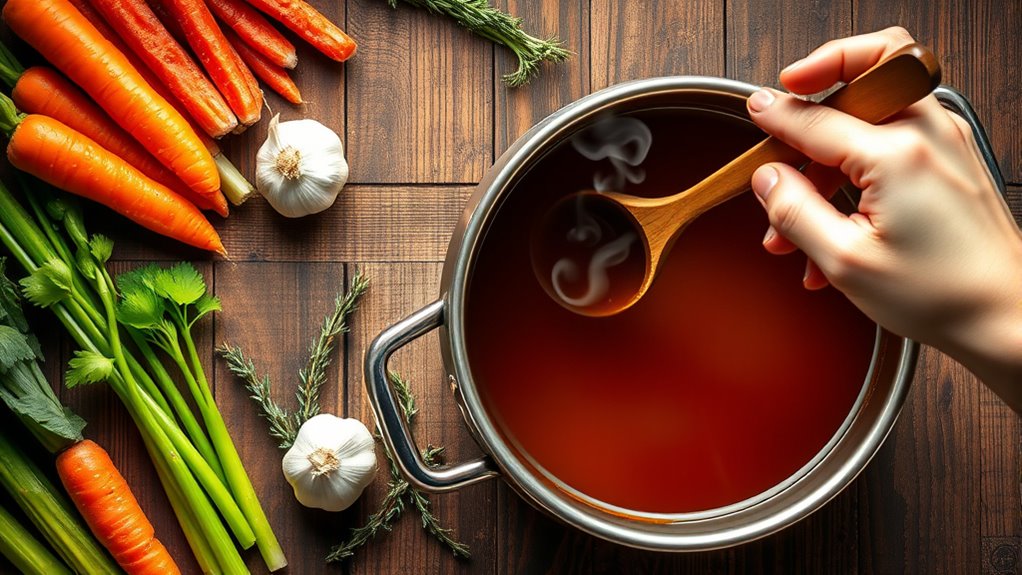Beef bone broth soup starts with 2–3 kg of bone, preferably marrow and connective tissue, covered with 4–6 L of cold water and a splash of acid to help gelatin extraction. Simmer gently at 185–205°F (85–96°C), skimming to keep it clear. Add aromatics after initial clarification, then strain and season to taste. This technique yields a nutrient-dense, collagen-rich broth that supports joint and gut health, with variations you can tailor to your flavors. You’ll learn more as you continue.
Ingredients and Quantity

For Beef Bone Broth Soup, the ingredients should be precise to guarantee consistent flavor and nutritional results. You’ll select items with documented composition, ensuring reproducible outcomes. Core components include bone, water, salt, and a balanced mix of aromatics; optional additions focus on collagen-rich elements to influence texture and mineral content. Beef types and cuts determine flavor depth and gelatin yield, so choose those with marrow and connective tissue when possible. Broth variations arise from marrow presence, simmer time, and acid pretreatment, which modulate extraction efficiency and clarity. Accurate quantities support consistency across batches.
| Item | Target Quantity |
|---|---|
| Bone (bone-in) | 2–3 kg |
| Water | 4–6 L |
Note: Maintain clarity, avoid fluff, and prioritize evidence-backed ratios for reproducibility.
Preparations

Preparing the bones and aromatics correctly sets the foundation for a clear, flavorful broth; start by rinsing bone-in pieces under cold water to remove residual blood and impurities. You’ll then trim excess fat if desired, but preserve marrow for body. For bone selection, prioritize joints with connective tissue and marrow-rich cuts to maximize gelatin and depth. Place bones in a large pot and cover with cold water, bringing to a gentle simmer to avoid emulsifying impurities. Skim regularly, discard scum, and add aromatics like onion, carrot, and celery after initial clarity forms. Simmering time matters: longer runs yield richer extraction, while brisk simmer risks bitterness. Maintain steady heat, monitor foam, and adjust with occasional water additions to sustain volume and balance.
Kitchen tools or Kitchenware Required

To make beef bone broth efficiently, assemble a focused set of tools: a heavy-bottom stockpot or Dutch oven, a fine-mesh skimmer, a long-handled ladle, and a sturdy colander. You’ll rely on these essential utensils to manage heat, remove solids, and strain broth cleanly, supporting consistent extraction and clarity. Kitchen gadgets optimize workflow, but keep it lean: select durable, nonreactive metal or heavy-duty glassware, and guarantee handles are secure. The following table highlights key tools and their roles, reinforcing evidence-based practice while preserving freedom of experimentation.
| Tool | Primary function |
|---|---|
| Heavy-bottom pot | Even heat distribution for reduction and extraction |
| Fine-mesh skimmer | Skim foam and impurities efficiently |
How to Cook

- Start by building a clear plan for simmering beef bone broth.
- Select a core technique tailored to your desired outcome.
- Use cold water to cover the bones completely.
- Add an acidic element (like vinegar) to help extract collagen.
- Bring the mixture to a gentle simmer, avoiding rapid boiling to preserve broth clarity.
- Skim regularly to remove impurities and maintain a clear broth.
- Maintain a steady temperature between 185–205°F (85–96°C) for several hours.
- Employ cooking techniques such as spaced simmering, gradual heat adjustments, and occasional rest periods to optimize marrow release and gelatin formation.
- In the final phase, experiment with herbs and spices to create broth variations.
- Observe how aromatics influence the broth’s body and mouthfeel.
- Record your outcomes to refine the process and ensure consistent, adaptable results.
How to Serve

When serving beef bone broth, start by warming portions gently to about the serving temperature to optimize mouthfeel and minimize gelatin separation. You’ll present it with purpose, balancing aroma, texture, and clarity to support a confident dining experience. Consider temperature control, vessel choice, and portion size as technical variables that influence perception. Below are evidence-informed options to enhance impact without fluff.
1) Serving suggestions: pre-warm bowls, garnish lightly with herbs, and offer a neutral palate cleanser between bites to reset flavor perception.
2) Presentation ideas: choose wide-mouth bowls for aeration, align broth surface with garnish height, and document color consistency for reproducibility.
3) Pairing logic: match with simple accoutrements that don’t obscure broth integrity.
4) Portioning method: measure servings precisely to maintain uniformity across plates.
Tips
Even with a solid base, small adjustments can yield measurable gains in broth quality; start by standardizing hydration and cooking times for bones to reduce variability in gelatin extraction and flavor extraction. You’ll want precise temperature control during initial blanching to remove impurities without compromising collagen integrity. Maintain a consistent simmer, not a boil, to minimize emulsified fats and maximize clarity. Use measured bone-to-water ratios and monitor headspace to optimize heat transfer and gelatinization. Introduce strategic aromatics later in the simmer to prevent overpowering the core beef profile. For broth variations, document batch parameters and tasting notes to identify reproducible tweaks. For flavor enhancement, consider finishing with a touch of acid or salt to release bound flavors while preserving mouthfeel and body.
Food Value and Benefit
Beef bone broth, made by simmering selected bones slowly, offers a nutrient-rich base packed with essential vitamins and minerals. This broth provides a wholesome source of hydration and supports overall health through its concentrated nutrients.
Benefits of consuming beef bone broth include:
- Hydration and Mineral Supply: Contains sodium, potassium, calcium, and magnesium that help maintain fluid balance and support nerve and muscle function.
- Gut Health Support: Rich in collagen and gelatin, which may promote gut lining repair and improve digestive transit.
- Immune System Support: Provides trace minerals such as zinc and iron that contribute to immune enzyme functions.
- Joint and Tissue Health: High levels of collagen and amino acids support joint comfort and tissue repair.
- Satiety and Energy: Protein content helps maintain steady energy levels and promotes a feeling of fullness.
Vitamins and minerals found in beef bone broth include calcium, magnesium, potassium, sodium, zinc, and iron, along with bioactive peptides that enhance nutrient absorption and immune response.
Frequently Asked Questions
Can I Substitute Beef Bones With Other Bones or Meats?
Yes—you can, but results vary. You can substitute with chicken bones or pork bones, adjusting simmer times and collagen release; monitor flavor, fat, and gelatin content to maintain a balanced, evidence-based broth that still honors your freedom to experiment.
How Long Can Broth Be Stored Safely in the Fridge?
Broth can be safely stored in the fridge for 3 to 4 days. For longer safety, freeze up to 2 to 3 months. Follow broth safety and storage guidelines, cooling promptly and sealing tightly after use.
Is Pressure Cooking Faster, and Does It Affect Flavor?
Yes, pressure cooking is faster and largely preserves nutrients; it can enhance flavor if you manage time and pressure. You’ll notice pressure cooking benefits, flavor enhancement techniques like controlled pressure, release method, and sustained simmer transcripts—freedom to optimize results.
Can I Freeze Broth in Larger or Smaller Portions?
Yes, you can freeze bone broth in various sizes. Use freezing methods like silicone molds or ice cube trays for portions, then transfer to labeled bags; choose portion sizes that fit your future recipes and thaw efficiently.
What Are Common Flavor Boosters I Should Avoid?
Common flavor boosters to avoid include excess artificial enhancers and overly salty seasonings; instead, use prudent flavor enhancers and balanced seasoning tips. You’ll want evidence-based adjustments, minimal additives, and transparent ingredient labels to preserve freedom and nutrition.
